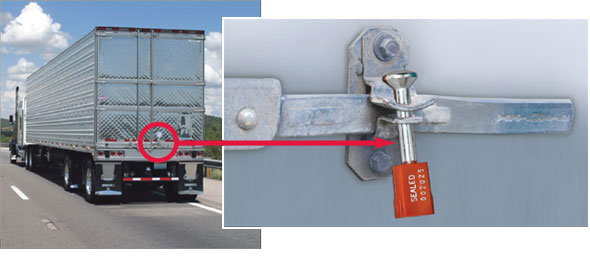Seals Series, Volume 2 —
Since our high school locker days, most of us are conditioned to think that the best way to keep things secure is with a lock.
In the Dangerous Goods world, though, locks aren’t always the best choice. When is a seal better than a lock? You might be surprised:
1. When you need to know if a package or door has been opened.
Locks are great, because you can lock and unlock them over and over. But that reusability is also their biggest weakness.
Any lock can be opened by anyone with the key or combination. Locks can also be picked, or destroyed with a bolt cutter and replaced with an identical lock. In any of those cases, you would never know if the package or door had been accessed—or if any of its contents had gone missing.
A seal, on the other hand, is meant for one use only. A numbered or barcoded cable seal, for instance, can’t be re-sealed or replaced. If it’s broken, you’ll know your security has been breached.
That’s an example of an indicative seal—a seal that demonstrates entry, but doesn’t prevent it. If you need to prevent entry as well, you want a barrier seal, like the one in the next example.
2. When it’s a matter of national security.
Because many hazardous materials could be targeted by terrorists, the government and commercial shippers have developed comprehensive cargo security programs for imports into the U.S., primarily applied to goods in intermodal containers and truck trailers.
These programs—the Customs-Trade Partnership Against Terrorism (C-TPAT)—specify high-security barrier seals that pass the highest strength test of ISO/PAS-17712.
C-TPAT compliant steel bolt seals are ideal for containers and truck trailers containing hazmat that requires the highest level of security.
3. When your shipment needs to be opened in a hurry.
If your package contains emergency medical supplies, you don’t want the recipient fumbling with a key or a combination. Secure the package with a simple, inexpensive pull-tight plastic seal instead—personalized and printed with sequential serial numbers, for tamper-evident security.
4. When you only need to keep something secure for the duration of a shipment.
If you ship a package or load a container with a lock, whoever receives it has to have the key. And key-control programs can be complicated—and expensive.
With a seal, the recipient just breaks the seal. Easy!
For low-security shipments, a simple, inexpensive cable tie will do. For higher-security shipments, steel cable seals remain a lightweight, inexpensive choice.
5. When your Dangerous Goods will be exposed to extreme environmental conditions.
Locks have moving parts that can rust, jam or freeze. Seals don’t.
When you’re securing a trailer or a shipping container for a January shipment through the upper Midwest—or storing something over the summer in muggy Florida—you’ll save yourself money and aggravation by choosing a seal over a lock.
Want to learn how seals can enhance your operation’s Dangerous Goods security? Call 800.621.5808 to speak with one of Labelmaster’s security seal experts.
Previous post:
Seals Series, Vol. 1: 11 places security seals are essential in Dangerous Goods
Next post:
Seals Series, Vol. 3: How a security seal control program protects your hazardous materials.





What do you call a lock with low self-confidence?
Insecure.
Sorry…